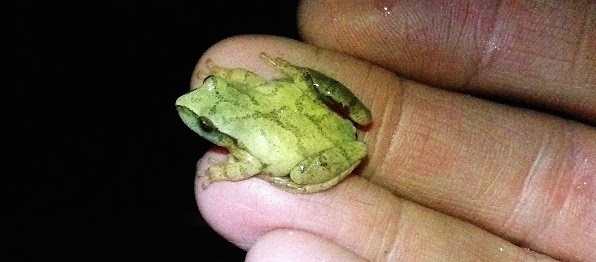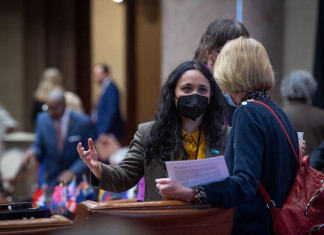
Early spring has arrived in the Hudson Valley, and soon will come a sight familiar to many local residents of driving age: frogs and salamanders hopping and wriggling across the road on dark and rainy nights. ‘Tis the season of amphibian migration.
Area conservation organizations, like the Winnakee Land Trust in Rhinebeck and the state Department of Environmental Conservation, refer to this migration period as “Big Night,” an event that usually takes place over a series of evenings in early spring, when nighttime temperatures regularly hit 40 degrees or more, and winter snows give way to rain.
Laurie Husted, chair of the Town of Red Hook’s Conservation Advisory Council, and a Big Night volunteer coordinator, has happy memories of her first experience with the mass migration, as amphibians moved from their over-winter pools to springtime breeding pools.
“I vividly recall an evening when I was 12, living in Rockland County, and my dad inching the car forward while my sister and I scooped up the frogs,” Husted said. “We were just trying to clear the pathway in front of our tires.”
More recently, an amphibian talk hosted by the Tivoli Free Library made Husted aware of another creature struggling alongside frogs on rainy roads: the spotted salamander.
“Have you ever seen one in the flesh? They’re huge–seven inches–and these guys are just plodding across the road,” Husted said. “I probably saved 10 my first year. I’ve subsequently found out they live up to 20 years when not flattened by a car.”
Saving frogs and salamanders from death by traffic is the primary goal of Big Night, as is mapping out areas where large numbers of amphibians are known to migrate. According to Lisa Camp, a volunteer coordinator for Winnakee and a member of the Town of Rhinebeck’s Conservation Advisory Board, raising public awareness is key.
“Since most of these crossings aren’t yet mapped, we are asked to go find them when conditions are right. The DEC needs our help, not only to provide safe passage for the amphibians, but to give local planning boards a heads-up if future development is proposed in the area,” she said.
While conservationists want to enlist as much help from the public as possible, Camp is careful to stress safety precautions, such as searching in groups of no fewer than two or three people, carrying flashlights, and wearing reflective clothing while searching.
Her advice for finding the critters? “Start on quiet back roads, near wetlands. Hearing peepers is a good indication of wet areas,” Camp said, noting that residents interested in helping shouldn’t be disappointed if they don’t find any amphibians their first night out.
“Last year, the most activity was between March 22 to 26 and usually occurring between 9pm and midnight. This year, however, the temperatures have been much cooler, so we’re expecting activity in the next week or so,” she said.
The night of April 4 was a significant night for crossings, according to volunteer reports, but migration could continue for longer if conditions are right. “Remember that Mother Nature is fickle. Let me know if your amphibians fail to show – there may still be another Big Night this spring,” Shannon Duerr of Winnakee advised volunteers in an email that day.
Camp advises gently picking amphibians up off the road and moving them towards the direction they were headed.
“Going out on a cold rainy night seems crazy,” Camp added. “But it’s absolutely thrilling to move these salamanders and frogs to safety, and it’s something that will make an immediate impact on our local environment.”
More information about how to volunteer for Big Night is available at the Winnakee Land Trust website, www.winnakeeland.org, or by calling Shannon Duerr at 845-876-4213.







Facebook Comments